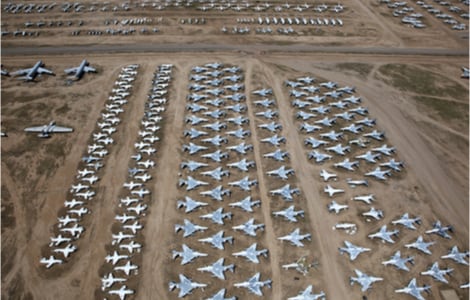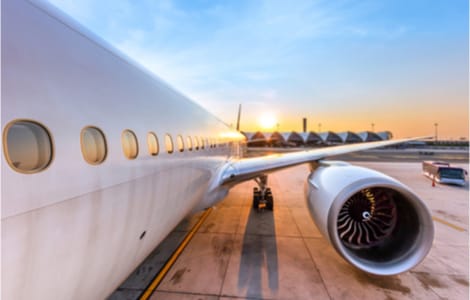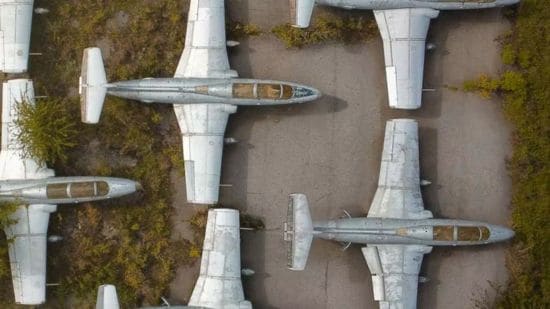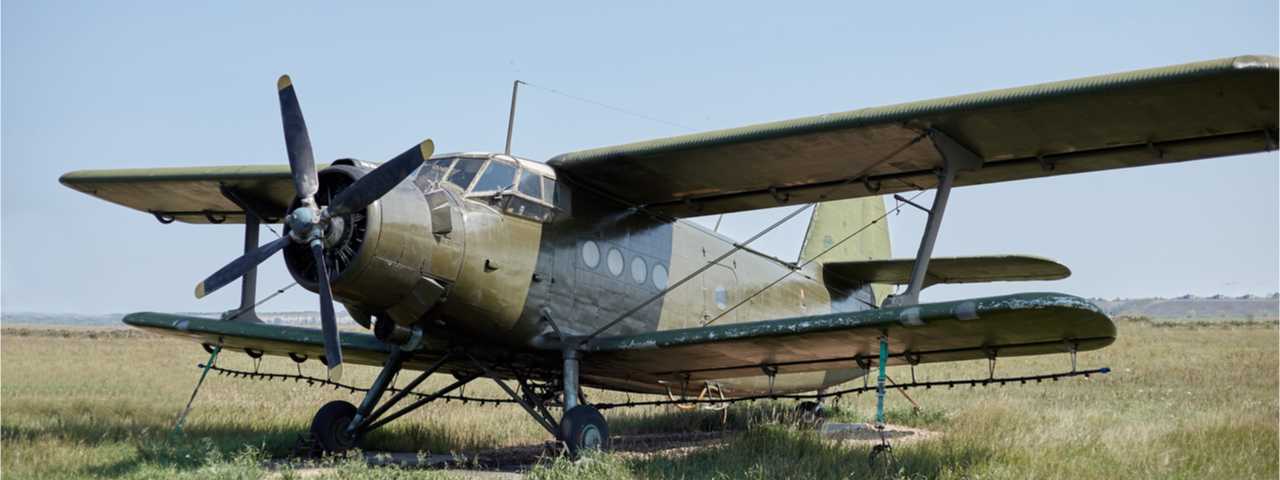The World Tour of Airplane Graveyards
There’s something strangely fascinating about airplane graveyards, or ‘boneyards’, as they’re sometimes called. Not only do they give visitors the chance to get up close and personal with some of the greatest jets, private aircraft, and airliners ever to take to the skies, but the spectacle of these iron hulks rusting away on the ground is somehow a reminder that everything – even these titans of the skies – eventually comes to an end.
Join us on a tour of four of the world’s most spectacular airplane graveyards.
1. ‘The Boneyard’ at Davis-Monthan Air Force Base, Tucson, Arizona, US


If you were to find yourself driving down South Kolb Road in Tucson, Arizona, you’d find yourself in full sight of a much more unusual view. Known to locals as ‘The Boneyard’, the 309th Aerospace Maintenance and Regeneration Group is thought to be the largest aircraft graveyard in the world.
Spread out in the desert under the scorching sun, this 10.5sq km graveyard – part of Davis-Monthan Air Force Base – is the final resting place for more than 3,280 decommissioned aircraft, including virtually every model of plane used by the US Military since the Second World War. Each year, on average, 251 aircraft arrive and around 281 depart. Yet, while many of the aircraft in The Boneyard have been stripped of any working parts, some still have potential strategic value, and as such are kept in a state of ‘combat readiness’, in case they’re needed in the future. Thanks to its large scale, the boneyard is often the only place to find the parts for older aircraft.
Davis-Monthan was chosen as a site to park decommissioned planes because of the dry Arizonan climate (the area only gets about 28cm of rainfall a year), which slows their degradation. This means that, for the most part, the planes are in relatively good condition.
For aircraft enthusiasts, The Boneyard is a veritable living history book of civilian and military aviation. You’ll see Boeing B-52 bombers from the Cold War parked next to McDonnell Douglas F-4 Phantoms from Vietnam, alongside passenger airliners including Boeing 707s. Top Gun fanatics will also be overwhelmed to know that Grumman F-14 Tomcat fighters are also among the retired aircraft. This place really is a ‘what’s what’ of aircraft design.
How to get there
If you want to see the world’s largest aircraft graveyard in person, all you have to do is book a private jet charter to Tucson International Airport (IATA code: TUS) through Air Charter Service (ACS). Davis-Monthan Air Force Base is only a 20-minute drive away from the airport.
2. Victorville, California, US
This boneyard is in one square kilometre of grounds at Southern California Logistics Airport, near Victorville, and can accommodate up to 500 aircraft. Located about 130km northeast of Los Angeles on the edge of the Mojave Desert, the boneyard’s warm and dry climate makes it the ideal place to keep aging airplanes for long periods of time.
The facility, also known as Victorville Airport, is located on the site of the former George Air Force Base, which was itself in active service from 1941 to 1992. Since March 2015, British Airways has stored quite a few of its Boeing 747s at this boneyard. As the average age of BA’s 747-400s fleet is now around 30 years, the airline has had to retire its older birds. Other airlines including Air New Zealand, Cathay Pacific, and Singapore Airlines have also sent some of their 747 fleets to Victorville.
How to get there
If you’d like to see the aircraft graveyard in Victorville, book a private plane rental to Southern California Logistics Airport (IATA code: VCV) through ACS.
3. Aircraft Cemetery, Poltava, Ukraine
The Aircraft Cemetery in Poltava, Ukraine has a long history. In the former Soviet Union, this was the site of the military flight training school, Pokryshkin (named after Soviet pilot Alexander Pokryshkin), where some of the best pilots in the communist state were trained.
The fall of the USSR saw the Ukrainian military start to decline, and in 1990, many of the country’s warplanes were transferred to Kazakhstan, leaving only the aircraft factory and pilot school behind. The school continued to operate in an independent Ukraine until 1994, when all flights stopped. The airbase officially closed in 2001 due to a lack of funding.
Today, the Poltava Aircraft Cemetery is a haunting reminder of the now-disbanded USSR’s power and influence over much of Eastern Europe. The most common sight at Poltava are the numerous Aero L-29 Delfín ‘corpses’, manufactured by Czechoslovakian aviation company Aero Vodochody, but you can also expect to see other attractions such as several decommissioned Mil MI-8 twin-turbine helicopters, as well as a hangar full of USSR aviation relics.
How to get there
To visit the Aircraft Cemetery in Poltava, charter a private flight with ACS and land at Poltava Airport (also known as Suprunovka Airport; IATA code: PLV). From there, it’s only a short drive to the Aircraft Cemetery.
4. Alice Springs Airport, Northern Territory, Australia
Alice Springs Airport in Australia’s Northern Territory is one of the youngest airplane graveyards in the world. It officially opened in 2014 after signing a 10-year contract with Asia Pacific Aircraft Storage and, like Davis-Monthan, was chosen for its exceptionally low humidity and warm climate. The maximum average temperature in summer is 35.6°C while minimum winter temperatures reach 5.1°C.
The entire facility covers an area of around 1.1sq km, but only 100,000sqm are currently being used to store derelict aircraft. However, storage expansion is underway to accommodate up to 200 more aircraft.
The variety of aircraft on show here isn’t quite on par with larger sites such as Tucson’s Boneyard at Davis-Monthan Air Force Base, due to the fact that Alice Springs stores a large number of intact aircraft in addition to derelict ones. But its otherworldly setting, surrounded by the deep red earth of the Outback, makes it a spectacular sight for intrepid visitors.
The airport is a repository for various aircraft that are awaiting resale or not being used by their airlines, so there’s a lot of traffic both in and out. In its opening year, as many as 25 planes had already come and gone, with only nine being stored permanently. Among the aircraft, you’ll find the Airbus A380, Boeing 747, and Boeing 777.
Alice Springs offers the perfect environment for retired aircraft and it is the first commercial aircraft storage and recycling facility in the Asia Pacific region.
How to get there
To visit the Alice Springs Graveyard, simply charter a private jet to Alice Springs Airport (IATA: ASP), and you’re all set. Contact us to plan your route and choose an appropriate aircraft for your journey.
Charter a private plane to your next destination with ACS
Which of these boneyards would you most like to visit? If you would like to plan a world tour of airplane graveyards, or simply find out more about charter flights for another purpose, please contact us at Air Charter Service (ACS). As well as offering helicopter and plane rentals for private customers, we can arrange group charters, and also provide other services, including cargo charters and specialist solutions.

 There’s something strangely fascinating about seeing some of the world’s best-known planes grounded for good. Join us on a tour of some of the world’s most spectacular airplane graveyards.
There’s something strangely fascinating about seeing some of the world’s best-known planes grounded for good. Join us on a tour of some of the world’s most spectacular airplane graveyards.


